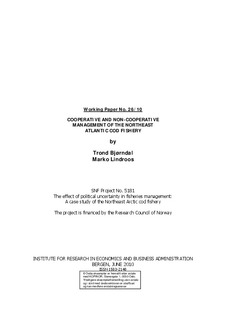| dc.contributor.author | Bjørndal, Trond | |
| dc.contributor.author | Lindroos, Marko | |
| dc.date.accessioned | 2010-10-19T12:51:01Z | |
| dc.date.available | 2010-10-19T12:51:01Z | |
| dc.date.issued | 2010-06 | |
| dc.identifier.issn | 1503-2140 | |
| dc.identifier.uri | http://hdl.handle.net/11250/166294 | |
| dc.description.abstract | The fishery for Northeast Atlantic cod (Gadus morhua) in the Barents Sea is one of the most valuable fisheries in the North Atlantic. After the introduction of Extended Fisheries Jurisdiction, cod is a shared stock between Norway and Russia. Overfishing of quotas has been a concern for a number of years. The purpose of this article is to analyse cooperative and non-cooperative management of the Northeast Atlantic cod fishery. This will be done in a game theoretic context, based on different assumptions regarding important variables such as cost of effort and initial stock size. The game theoretic analysis will be based on an empirical bioeconomic model developed and estimated by Hannesson (2007, 2010). The case of cooperative management is analysed for different cost parameters and starting values of the stock. An interesting result is that the optimal policy gives rise to pulse fishing. As this involves effort (and harvests) varying from year to year, potentially imposing substantial social costs on the industry in years when the fishery is closed, a policy of constant effort is also considered. Finally, non-cooperative management is analysed. | en |
| dc.language.iso | eng | en |
| dc.publisher | SNF | en |
| dc.relation.ispartofseries | Working paper | en |
| dc.relation.ispartofseries | 2010:26 | en |
| dc.title | Cooperative and non-cooperative management of the northeast atlantic cod fishery | en |
| dc.type | Working paper | en |
| dc.subject.nsi | VDP::Samfunnsvitenskap: 200::Økonomi: 210::Samfunnsøkonomi: 212 | en |
| dc.subject.nsi | VDP::Landbruks- og Fiskerifag: 900::Fiskerifag: 920 | en |
